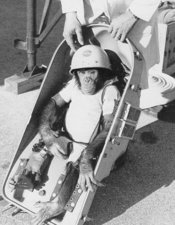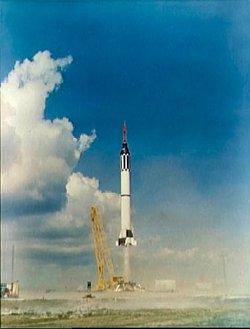Mercury-Redstone 2
|
|
| Mission Insignia | |
|---|---|

| |
| Mission Statistics | |
| Mission Name: | Mercury MR-2 |
| Call Sign: | MR-2 |
| Number of Crew Members: | 1 primate |
| Launch: | January 31, 1961 16:55 UTC Cape Canaveral Complex 5 |
| Landing: | January 31, 1961 17:12 |
| Duration: | 16 min 39 s |
| Number of Orbits: | suborbital |
| Apogee: | 157 mi (253 km) |
| Distance Traveled: | 422 mi (679 km) |
| Maximum velocity: | 5,857 mph 9,426 km/h |
| Peak acceleration: | 14.7 g (144 m/s²) |
| Mass: | 1,203 kg |
| Crew Picture | |
| Ham the Chimp | |
Mercury-Redstone 2 (MR-2) was launched at 16:55 UTC on January 31, 1961 from LC-5 at Cape Canaveral, Florida. Mercury spacecraft # 5 carried Ham the Chimp as a passenger on a suborbital space flight launched on Redstone MRLV-2.
Spacecraft # 5 contained six new systems that had not been on previous flights: environmental control system, attitude stabilization control system, live retrorockets, voice communications system, "closed loop" abort sensing system, and a pneumatic landing bag.
The previous Mercury-Redstone mission, MR-1A, flew a trajectory that was too steep with accelerations too high for a human passenger. MR-1A had climbed to its programmed apogee of about 130 miles (209 km) and landed 235 miles (378 km) downrange. Mercury-Redstone 2 would follow a more flattened trajectory. Its planned flight path was an apogee of 115 miles (185 km) and a range of 290 miles (467 km).
Six chimpanzees (four female and two male) and twenty medical specialists and animal handlers from Holloman Air Force Base, New Mexico, where the chimps live and were trained, were moved into quarters behind Hangar "S" at Cape Canaveral, Florida, on January 2, 1961. The six chimps were trained in Mercury simulators for three weeks. The day before the flight, two chimps were chosen for the mission. One primary, Ham, and one backup, a female chimp named Minnie. The competition was fierce, but Ham was full of energy and good humor. Ham was named in honor of Holloman Aerospace Medical Center. Ham was from Cameroun, Africa, (original name Chang, Chimp # 65). He was purchased by the USAF July 9, 1959.
At 12:53 UTC, January 21, 1961, Ham was inserted into the spacecraft. The countdown was then delayed almost four hours because of a hot inverter, and several other minor problems.
Finally at 16:55 UTC the MR-2 lifted off. Computers reported one minute after launch, the flight path angle was at least one degree high and rising. At two minutes, the computers predicted a 17 g (167 m/s²) acceleration. At 2 minutes 17 seconds into the flight, the liquid oxygen supply was depleted. The closed-loop abort system sensed a change in engine chamber pressure when the LOX supply was depleted and fired the launch escape system. The abort signalled a Mayday message to the recovery forces.
The high flight angle, and the early abort, caused the maximum velocity of the spacecraft to be 7,540 ft/s (2,298 m/s) instead of the planned 6,465 ft/s (1,970 m/s). The retrorockets had been jettisoned during the abort and therefore could not be used to slow down the spacecraft. All of this added up to an overshoot of the planned landing area by 130 miles (209 km) and an apogee of 157 miles (253 km) instead of 115 miles (185 km).
Another problem occurred at 2 minutes and 18 seconds into the flight, when cabin pressure dropped from 5.5 to 1 lb/in² (38 to 7 kPa). This malfunction was traced later to the air inlet snorkel valve. Vibrations had loosened a pin in the snorkel valve and allowed the valve to open. Ham was safe in his own couch spacesuit and did not suffer any ill effects from the loss of cabin pressure. His couch spacesuit pressure remained normal, and suit temperature stayed well within the 60 to 80 degrees Fahrenheit (16 to 26 °C) optimum range.
Because of overacceleration of the launch vehicle and the boost from the escape rocket, a speed of 5,857 mph (9,426 km/h) was reached instead of the 4,400 mph (7,081 km/h) planned. At apogee Ham's spacecraft was 48 miles (77 km) farther downrange than planned. Ham was weightless for 6.6 minutes instead of the 4.9 minutes that were planned. The spacecraft landed 422 miles (679 km) downrange after a 16.5 minute flight. He received 14.7 g (144 m/s²) during reentry, almost 3 g (29 m/s²) greater than planned.
Ham performed his tasks well, pushing levers about 50 times during the flight. Onboard cameras filming Ham's reaction to weightlessness showed a surprising amount of dust and debris floating around inside the capsule during apogee.
The spacecraft touched down, about 12:12 p.m., out of sight from recovery forces. About 12 minutes later, the first recovery signal was received from the spacecraft. Tracking showed it was about 60 miles (96 km) from the nearest recovery ship. Twenty-seven minutes after landing, a search plane sighted the capsule floating upright in the Atlantic. The search plane requested that the Navy send its rescue helicopters from closest ship carrying them. When the helicopters arrived they found the spacecraft on its side, taking on water, and submerging. The beryllium heat shield upon water impact had bounced against the capsule bottom, punching two holes in the titanium pressure bulkhead. The landing bag had worn badly, and the heatshield was torn free from the spacecraft before recovery. After the craft capsized, the open snorkel valve let still more sea water enter the capsule. When the helicopter crew finally latched onto and picked up Ham's spacecraft at 18:52 UTC., they estimated there was about 800 pounds (363 kg) of sea water aboard. The spacecraft was flown to and lowered to the deck of the USS Donner. When the spacecraft was opened Ham appeared to be in good condition and readily accepted an apple and half an orange.
Ham was 3 years 8 months old at launch. After his spaceflight he retired to the National Zoo in Washington, D.C. for 17 years and then in 1981 was moved to a zoo in North Carolina to live with a colony of other chimps. He died on January 19, 1983, at the age 25. Ham is buried at the International Space Hall of Fame in Alamogordo, New Mexico. He was one of many animals in space.
Ham's backup, Minnie was the only female chimp trained for the Mercury program. After her role in the Mercury program ended, Minnie became part of an Air Force chimp-breeding program, producing nine offspring and helping raise the offspring of several other members of the chimp colony. She was the last surviving astro-chimp. She died at age 41 on March 14, 1998. Minnie is buried next to Ham at the International Space Hall of Fame in Alamogordo, New Mexico.
With all of the malfunctions during the flight, the Mercury-Redstone was still not ready for a human passenger. MR-3 was postponed for a booster development flight, Mercury-Redstone BD.
Mercury spacecraft # 5 used in the Mercury-Redstone 2 mission, is currently displayed at the California Museum of Science and Industry, Los Angeles, California. Mercury spacecraft #5 display page on A Field Guide to American Spacecraft website. (http://aesp.nasa.okstate.edu/fieldguide/pages/mercury/merc_mr-2.html)
Reference
- This New Ocean: A History of Project Mercury - NASA SP-4201 (http://www.hq.nasa.gov/office/pao/History/SP-4201/cover.htm)
- NASA NSSDC Master Catalog (http://nssdc.gsfc.nasa.gov/nmc/sc-query.html)
See also
Mercury Redstone Sub-Orbital Flight Events
| T+ Time | Event | Description |
|---|---|---|
| T+00:00:00 | Liftoff | Mercury-Redstone lifts off, onboard clock starts. |
| T+00:00:16 | Pitch Program | Redstone pitches over 2 deg/s from 90 deg to 45 deg. |
| T+00:00:40 | End Pitch Program | Redstone reaches 45 deg pitch. |
| T+00:01:24 | Max Q | Maximum dynamic pressure ~575 lbf/ft² (27.5 kPa). |
| T+00:02:20 | BECO | Redstone engine shutdown - Booster Engine Cutoff. Velocity 5,200 mph (2.3 km/s) |
| T+00:02:22 | Tower Jettison | Escape Tower Jettison, no longer needed. |
| T+00:02:24 | Capsule Separation | Posigrade rockets fire for 1 s giving 15 ft/s (4.6 m/s) separation. |
| T+00:02:35 | Turnaround Maneuver | Capsule (ASCS) system rotates capsule 180 degrees, to heat shield forward attitude. Nose is pitched down 34 degrees to retro fire position. |
| T+00:05:00 | Apogee | Apogee of about 115 miles (185 km) reached at 150 miles (240 km) downrange from launch site. |
| T+00:05:15 | Retrofire | Three retro rockets fire for 10 seconds each. They are started at 5 second intervals, firing overlaps. Delta V of 550 ft/s (168 m/s) is taken off forward velocity. |
| T+00:05:45 | Retract Periscope | Periscope is automatically retracted in preparation for reentry. |
| T+00:06:15 | Retro Pack Jettison | One minute after retrofire retro pack is jettisoned, leaving heatshield clear. |
| T+00:06:20 | Retro Attitude Maneuver | (ASCS) orients capsule in 34 degrees nose down pitch, 0 degrees roll, 0 degrees yaw. |
| T+00:07:15 | .05 G Maneuver | (ASCS) detects beginning of reentry and rolls capsule at 10 degrees per second to stabilize capsule during reentry. |
| T+00:09:38 | Drogue Parachute Deploy | Drogue parachute deployed at 22,000 ft (6.7 km) slowing descent to 365 ft/s (111 m/s) and stabilizing capsule. |
| T+00:09:45 | Snorkel Deploy | Fresh air snorkel deploys at 20,000 ft (6 km). (ECS) switches to emergency oxygen rate to cool cabin. |
| T+00:10:15 | Main Parachute Deploy | Main parachute deploys at 10,000 ft (3 km). Descent rate slows to 30 ft/s (9 m/s) |
| T+00:10:20 | Landing Bag Deploy | Landing bag deploys, dropping heat shield down 4 ft (1.2 m). |
| T+00:10:20 | Fuel Dump | Remaining hydrogen peroxide fuel automatically dumped. |
| T+00:15:30 | Splashdown | Capsule lands in water about 300 mi (500 km) downrange from launch site. |
| T+00:15:30 | Rescue Aids Deploy | Rescue aid package deployed. The package includes green dye marker, recovery radio beacon and whip antenna. |
| Previous Mission: Mercury-Redstone 1A |
Mercury | Next Mission: Mercury-Atlas 2 |


